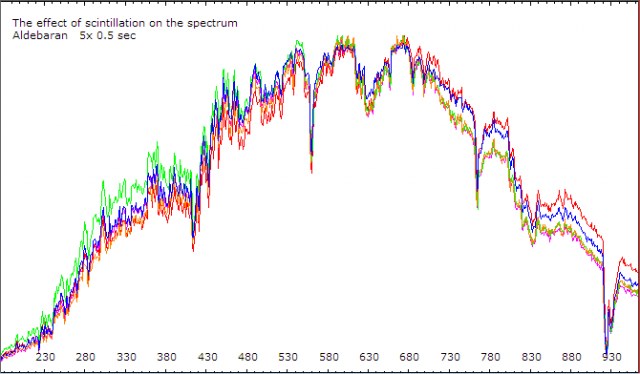› Forums › Spectroscopy › Scintillation and ALPY spectra
- This topic has 5 replies, 3 voices, and was last updated 6 years, 9 months ago by
 John Coffin.
John Coffin.
-
AuthorPosts
-
7 November 2016 at 11:25 am #573631
 Robin LeadbeaterParticipant
Robin LeadbeaterParticipantJust as in photometry, the effects of scintillation in short exposures affects spectroscopy. It does not just affect the intensity though, the shape of the spectrum is also affected. (Which is why I mentioned at the recent workshop that care needs to be taken if using Vega as reference star for the ALPY)
As an example, on Saturday I made a series of test spectra of MILES stars in Taurus to determine how precise my spectra typically are. (Full report to follow) One of these was HD29139 (Aldebaran). Because it is so bright, the exposures were only 0.5 sec. Even after averaging 10 exposures the deviations from the spectrum in the MILES database were still of the order of +-10%. Looking at the individual raw spectrum profiles, the reason was obvious. Scintillation was severely distorting the individual spectra. The plot below shows 5 individual 0.5 second raw profiles.
Cheers
Robin

Attachments:
18 December 2018 at 10:53 pm #580411 John CoffinParticipant
John CoffinParticipantDoes scintillation shift the wavelength of spectra? What would be a reasonable minimum exposure time to avoid problems due to scintillation?
18 December 2018 at 11:54 pm #580412 Hugh AllenParticipant
Hugh AllenParticipantHi Robin,
I guess it’ll be in your full report but what was the altitude of Aldebaran in this case? I work in alt-az mode and orient my slit vertically which I think should minimise this effect?
Cheers
Hugh
P.S Just noticed your original post was a little while ago!
19 December 2018 at 12:57 am #580413 Robin LeadbeaterParticipant
Robin LeadbeaterParticipantThe slit normally defines the location of a given wavelength in the spectrum but if the slit is wider than the star image then I guess there could be some wavelength shift between exposures due to scintillation. To avoid scintillation problems (and uneven coverage of the slit due to guiding errors) I normally accumulate at least 1 min total exposure time for a spectrum (which for bright targets at low resolution can be in shorter sub exposures), though this is not based on any scientific analysis.(I see I only used 30 sec for eps Tau in this particular exercise)
https://britastro.org/sites/default/files/attachments/ALPY600_MILES_tests_20161105.pdf
19 December 2018 at 2:01 pm #580414 Robin LeadbeaterParticipant
Robin LeadbeaterParticipantHi Hugh,
Digging out the report I see Aldebaran was recorded at 45 deg altitude
I dont think scintillation effects are directional are they ? I would expect the effect to be independent of the slit orientation. Orientating the slit vertically relative to the horizon (the paralactic angle) will help with atmospheric dispersion problems though which can give systematic errors due to selective sampling by wavelength at the slit.
Cheers
Robin
EDIT: Actually thinking about it a bit more, I think there are two potential effects here.
Movement of the star image coupled with selective sampling at the slit due to atmospheric dispersion which could be reduced by orientating the slit
Distortion of the spectrum due to scintillation which is seen even in the absence of the slit (eg in Star Analyser spectra) and is seen visually as apparent colour changes in the star
4 April 2019 at 5:51 pm #580930 John CoffinParticipant
John CoffinParticipantDear Hugh, I read that you work in alt-az mode to avoid the effects of atmospheric dispersion. I’d be interested to know how you do this. I have an AZ-EQ6 Mount but haven’t tried the AZ mode. I normally guide on a different star to the target. Does field rotation interfere with your guiding? Do you have more difficulty synchronising your telescope to your planetarium software? I’ve been put off trying AZ mode because I had heard that it’s “go to“ function was not so accurate.
-
AuthorPosts
- You must be logged in to reply to this topic.
